

Making natural cordage (string) is not only an invaluable skill in the outdoors but is also immensely satisfying and enjoyable. But beware … it’s addictive! I often find myself picking materials and mindlessly twisting cordage as I walk through the woods. This is also a skill I love practising with children. Any strong flexible fibre can be used to make cordage – the inner bark of most trees or the dried inner skin of fibrous plants will work well but do experiment with different materials and find your own favourite. I like clematis bark, spruce root and nettle, amongst others.
1. First, we need to make the ‘eye’. Take a long length of your fibres and hold them one-third along the length rather than in the centre – this is because if we need to add more length to the cordage, this will be done at different times to avoid compromising the strength of the cordage. Simply twist the fibres between your thumb and forefinger in different directions until a kink appears.

2. Hold the kink in one hand and, using your stronger hand, twist one set of fibres away from you.

3. Keeping the fibres twisted, swap the two strands over and twist. Move the helping hand further up to pinch where the two strands now meet.
Carry on until you reach the desired length. If you run out of fibres on one side, simply twist a new length in with the existing fibres and continue!